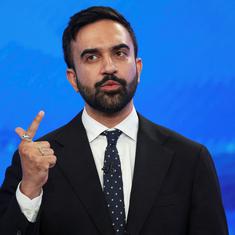Fraternity, our common sisterhood and brotherhood, would, if fully realised, result in a seamless oneness, or unity, amidst our limitless diversities. This is an ideal we as a people have never achieved. Instead of complete unity, we articulate interim ideals of amity, harmony and peaceful co-living. These in turn require at the minimum two fundamental principles in public life – of public civility and public fairness. Both these minimum principles for fraternal co-living have been badly battered in the first year of Modi’s stewardship of the central government.
Public civility
Take first public civility. Never in free India has the public discourse been so poisoned by MPs and ministers of an elected ruling alliance. Bharatiya Janata Party MP Sakshi Maharaj labels madrasas as “hubs of terror” fostering “love jihad” and “education of terrorism”. He exhorts Hindu women to bear four children, declaring that in the Modi yug (era), the alleged Muslim practice of having four wives and 40 kids – a fiction of majoritarian paranoia – should be forcefully halted. He further describes Nathuram Godse, Gandhi’s assassin, as a “patriot” and “martyr”. Another BJP MP Yogi Adityanath declares that an India without Ram cannot be imagined, and that those who allegedly torment Hindus with riots will have to pay dearly. Moreover “for every Hindu converted, 100 Muslim girls will be converted as retaliation”. Minister Sadhvi Niranjan Jyoti describes those who do not worship Ram as “haramzade” or bastards. A Shiv Sena MP force-feeds a Muslim canteen functionary during his roza fast. Another, Sanjay Raut, calls for the disenfranchisement of Muslims.
These are not hate provocations by non-state fringe fanatics. These are displays of unrepentant public bigotry by elected public representatives of the ruling alliance in Parliament. The prime minister – who is otherwise not known ever to be at a loss for words, prides himself on an expanded chest and imposing his iron will on his ministers and party – is deafening in his silence in response to these criminally culpable hate statements of his colleagues. His occasional reactions, hardly amount to even a mild rap on their knuckles.
Public fairness
Take now public fairness. Consider the state of Gujarat. Maya Kodnani, imprisoned for 28 years for leading the brutal slaughter in Naroda in 2002 of 97 Muslims, including 36 women and 35 children, is out on bail for an intestinal malady since July 2014. Another infamous organiser of the slaughter, Baju Bajrangi, also serving an extended life term, was freed on bail for an eye aliment in April 2015. Caught in 2006 by the newsmagazine Tehelka on secret camera Bajrangi had bragged, “We hacked, burned, set on fire… because these bastards don’t want to be cremated… I have just one last wish… let me be sentenced to death… just give me two days before my hanging and I will go and have a field day… I will finish them off… at least 25,000 to 50,000 should die.”
Senior police officer Vanzara, charged with the murder in fake encounters of teenager Ishrat Jehan, Sohrabuddin and others, was released on bail in February 2015 to a hero’s welcome. In contrast, courageous whistle-blowing police officers Rahul Sharma and Rajnish Rai face a barrage of charges. An exhausted but unbending Sharma finally took voluntary retirement. Police officer Sanjeev Bhatt remains suspended. Gutsy Teesta Setlawad, who pursued many battles for legal justice for the survivors of the 2002 carnage, faces multiple criminal charges and escaped imminent arrest only through the intervention of the Supreme Court.
Communal ferment
India’s Constitution took care to defend not just the right of faith of religious minorities, but also their right to propagate their convictions. Contrary to its spirit, there is influential public advocacy for a national law barring religious conversions. A rash of high-decibel programmes were organised in which converts to Islam and Christianity were “welcomed back” into Hinduism. These programmes were titled “homecomings”, suggesting that the legitimate Indian faith is Hinduism, and conversions to Islam and Christianity represented prodigal straying. The same cultural hegemony of majoritarian upper-caste Hinduism underlay Maharashtra government’s ban on both selling and eating beef, criminalising dietary traditions of not only many non-Hindu faiths, but even many Dalit and tribal peoples.
This has also been a year of widespread communal ferment. Big communal conflagrations are now unlikely, because they attract international condemnation and troublesome domestic activism. But these have been replaced by an undeclared continual epidemic of small, but deeply toxic, communal attacks and skirmishes across the length and breadth of the land. Assaults on churches here, disputes over mosques and cemeteries there, raids on religious processions, throwing of animal carcasses into shrines, raising of communal tempers when young people choose to love or marry outside their religions, and against cow slaughter, all of these have resulted in several hundred communal clashes throughout the country, peaking in regions which are due to face elections.
Modi in his first year in office has led our nation into a long, blistering majoritarian summer. This has scorched both the fairness of institutions of the state – including sadly the judiciary – as well as fraternal social relations. None but the most delusional right-wing radicals expect millions of people of minority faith to leave this nation. But what they want is that these millions learn to live in separate ghettoes, economically enfeebled, socially submissive, politically disenfranchised. This is their competing idea of India.










